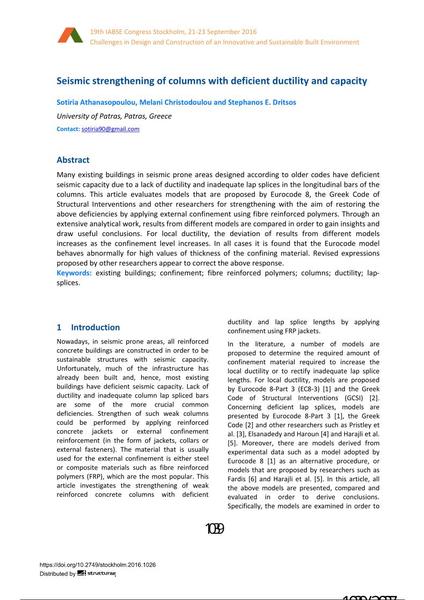Seismic strengthening of columns with deficient ductility and capacity

|
|
|||||||||||
Bibliografische Angaben
| Autor(en): |
Sotiria Athanasopoulou
(University of Patras, Patras, Greece)
Melani Christodoulou (University of Patras, Patras, Greece) Stephanos Dritsos (University of Patras, Patras, Greece) |
||||
|---|---|---|---|---|---|
| Medium: | Tagungsbeitrag | ||||
| Sprache(n): | Englisch | ||||
| Tagung: | IABSE Congress: Challenges in Design and Construction of an Innovative and Sustainable Built Environment, Stockholm, Sweden, 21-23 September 2016 | ||||
| Veröffentlicht in: | IABSE Congress Stockholm, 2016 | ||||
|
|||||
| Seite(n): | 1039-1046 | ||||
| Anzahl der Seiten (im PDF): | 8 | ||||
| Jahr: | 2016 | ||||
| DOI: | 10.2749/stockholm.2016.1026 | ||||
| Abstrakt: |
Many existing buildings in seismic prone areas designed according to older codes have deficient seismic capacity due to a lack of ductility and inadequate lap splices in the longitudinal bars of the columns. This article evaluates models that are proposed by Eurocode 8, the Greek Code of Structural Interventions and other researchers for strengthening with the aim of restoring the above deficiencies by applying external confinement using fibre reinforced polymers. Through an extensive analytical work, results from different models are compared in order to gain insights and draw useful conclusions. For local ductility, the deviation of results from different models increases as the confinement level increases. In all cases it is found that the Eurocode model behaves abnormally for high values of thickness of the confining material. Revised expressions proposed by other researchers appear to correct the above response. |
||||
| Stichwörter: |
Duktilität Säulen faserverstärkte Kunststoffe
|
||||
